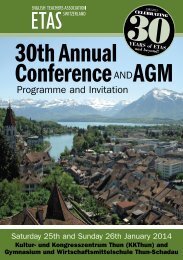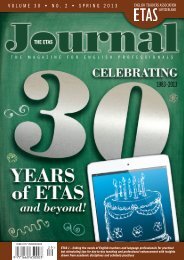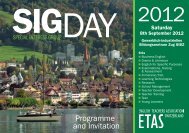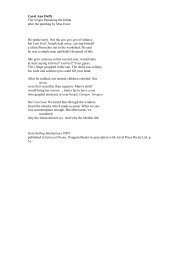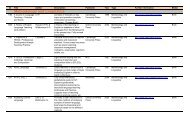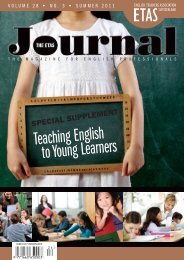The Magazine for English Professionals - English Teachers ...
The Magazine for English Professionals - English Teachers ...
The Magazine for English Professionals - English Teachers ...
You also want an ePaper? Increase the reach of your titles
YUMPU automatically turns print PDFs into web optimized ePapers that Google loves.
SIGDAY<br />
Special Interest Group<br />
Teacher Training SIG (TT SIG)<br />
A10<br />
Language as a topic <strong>for</strong> the task-based<br />
classroom<br />
Dave Willis<br />
<strong>The</strong> stated aims of this workshop were:<br />
1) to show how language itself can be a<br />
relevant and worthwhile topic <strong>for</strong> learners,<br />
and 2) to use the insights gained from looking<br />
at language to develop lesson plans <strong>for</strong><br />
intermediate-level learners. <strong>The</strong> first aim was<br />
completely fulfilled but time limitations meant<br />
that <strong>for</strong> the second aim, participants came<br />
away with ideas rather than developed lesson<br />
plans. However, <strong>for</strong> most of the approximately<br />
thirty experienced teachers who took part, this<br />
was clearly acceptable.<br />
We looked first at some of the language topics<br />
we might ask learners to consider. <strong>The</strong>se<br />
included: collocation, how to be polite, fixed<br />
phrases, what is a dialect, and even, what is<br />
a language. Bees, whales and dolphins communicate<br />
but do they tell jokes and lies? Does<br />
this ability define language?<br />
We then focused on the differences between<br />
spoken and written language using a<br />
transcription of a recording of native speakers.<br />
Particular features of spoken language<br />
such as unusual word order resulting from<br />
bringing together the main topic points early<br />
in a statement, and frequent repetition, were<br />
noted and discussed. This led naturally to<br />
the subject of vague language exemplified in<br />
words and phrases like ‘sort of’, or ‘around’,<br />
‘about’, and so on. Do native speakers use<br />
these imprecise terms in order to sound less<br />
threatening? What are the equivalent terms<br />
in other languages? Do <strong>English</strong> speakers use<br />
these more than German speakers do?<br />
Such examination of language may seem<br />
rather theoretical, but learners as well as<br />
teachers can find such aspects valuable.<br />
As far as practical application is concerned,<br />
I immediately thought of its usefulness <strong>for</strong><br />
Cambridge classes: put a transcript of a spoken<br />
narrative into an acceptable written <strong>for</strong>m,<br />
eliminate redundancy, make the language<br />
more <strong>for</strong>mal, <strong>for</strong> example. <strong>Teachers</strong> of exam<br />
classes usually already do these things with<br />
their students, but the task-based approach<br />
certainly contributes focus and structure. It<br />
would have been interesting to have developed<br />
a lesson plan <strong>for</strong> a General <strong>English</strong><br />
class.<br />
Thank you, Dave Willis, <strong>for</strong> a stimulating work-<br />
30 ETAS Journal 24/3 Summer 2007<br />
shop accompanied by an excellent handout.<br />
Julia Blackwell<br />
Teacher Training SIG (TT SIG) & Young<br />
Learners SIG (YL SIG)<br />
B 10/12<br />
Using TPR creatively in the primary<br />
classroom<br />
Graham Workman<br />
Using Total Physical Response creatively in<br />
the classroom appealed to me as I expected it<br />
to be an active workshop, and I wasn’t disappointed.<br />
<strong>The</strong> room filled as Graham Workman<br />
welcomed everyone personally.<br />
First we were asked to predict how TPR<br />
works and then compared this to a toddler<br />
learning his first language. We watched a<br />
short documentary film from James Asher<br />
and saw that children learn in a stress-free<br />
environment and they first speak when they<br />
are ready. <strong>The</strong>ir initial language is mostly<br />
commands and they respond physically which<br />
means they listen and understand be<strong>for</strong>e they<br />
speak. We learned that TPR tries to mimic<br />
the way children learn their first language.<br />
Graham gave us many examples on how to<br />
use TPR, well, actually he made us do them.<br />
<strong>The</strong> class followed Japanese commands such<br />
as walk, run, and jump. Through the actions<br />
and repetition we learned the words. Later we<br />
were jumping out of bed, making coffee, and<br />
singing in the shower to see how we were<br />
learning the language through everyday situations.<br />
We were not only learning words like<br />
milk and chocolate, but through actions the<br />
collocation along with them, drinking milk and<br />
eating chocolate.<br />
Graham showed that TPR can be as simple<br />
as a cut and paste activity. After a physical<br />
break chant filled with rhyme and action to<br />
bring oxygen back into the brain, we thought<br />
of known stories where TPR elements could<br />
be used. <strong>The</strong> last activity showed the<br />
effectiveness of miming, and we were acting<br />
out gorillas, clowns, and toilets. This workshop<br />
showed the benefits of using TPR and<br />
many excellent examples.<br />
We learned by doing that TPR is memorable,<br />
kinesthetic and creates a sense of success. It<br />
is aptitude free, can be used <strong>for</strong> adults as well<br />
as children, and can be integrated with little<br />
preparation. Most of all Graham, allowed us to<br />
make the experience ourselves that learning<br />
with TPR means less stress and less stress<br />
equals more learning. Thanks to Graham <strong>for</strong><br />
another well-presented and action packed<br />
workshop.<br />
Sharon Mettler<br />
Teacher Training SIG (TT SIG)<br />
C10<br />
Writing to read: reading to write<br />
Antoinette Moses<br />
<strong>The</strong> aims of Antoinette Moses workshop were<br />
to demonstrate how classroom readers can<br />
be used in creative writing assignments that<br />
develop students’ writing skills as well as<br />
reading comprehension.<br />
<strong>The</strong> workshop included hands-on writing of<br />
short stories based on different angles that<br />
were created using her reader Jojo’s Story, a<br />
story about a child soldier with an unspecified<br />
location, which allows the reader to imagine it<br />
takes place anywhere in the world. She created<br />
writing assignments that developed our<br />
creativity by having us write from the perspective<br />
of the news journalist covering the story<br />
or from the child soldier that murders Jojo’s<br />
family. It was incredibly inspirational.<br />
We also wrote poems based on clues and<br />
questions given by her. <strong>The</strong>n we read the<br />
actual published poems, which had inspired<br />
the assignment, such as: This is Just to Say<br />
by William Carlos Williams, and Cats Sleep<br />
Anywhere by Eleanor Farjeon. It was delightful<br />
and intriguing.<br />
She offered so many ideas and resources that<br />
provided us with many exercises which we<br />
could take back and use in the classroom on<br />
Monday. I personally liked the eye-opening<br />
topics and being able to write about themes<br />
that I never thought about, such as the<br />
immense problem of children soldiers in the<br />
world today. Also, receiving ideas that students<br />
would actually really relate to was priceless.<br />
All of the participants were positively<br />
moved by this excellent workshop and gave<br />
rave reviews and feedback of this workshop.<br />
Tracy Tobler



